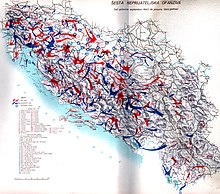
Back Operación Kugelblitz Spanish Opération Kugelblitz French Operacija Kugelblitz Croatian Operazione Kugelblitz Italian Операция «Шаровая молния» (декабрь 1943) Russian Operacija Kugelblitz Serbo-Croatian Операција Кугелблиц Serbian Операція «Кугельбліц» Ukrainian
| Operation Kugelblitz | |||||||
|---|---|---|---|---|---|---|---|
| Part of World War II in Yugoslavia | |||||||
 Map of Partisan movements during the offensive | |||||||
| |||||||
| Belligerents | |||||||
|
Axis and collaborationist forces: |
Allies: | ||||||
| Commanders and leaders | |||||||
|
|
| ||||||
| Strength | |||||||
| c. 30,000 German, NDH, and Chetnik troops | c. Around 12,000 troops | ||||||
| Casualties and losses | |||||||
| 6,700 casualties | 9,000 casualties | ||||||
Operation Kugelblitz (German: Unternehem Kugelblitz) was a massive counter-insurgency operation by the German 2nd Panzer Army conjunction with collaborationist forces against the Yugoslav Partisans around the eastern Bosnian region of the Independent State of Croatia during World War II. Launched on 3 December 1943, the objective of Kugelblitz was to encircle and destroy Partisan positions around the eastern part of the NDH, who were planning to regroup in occupied Serbia. The events of Operation Kugelblitz are associated with the Sixth Enemy Offensive (Serbo-Croatian: Šesta neprijateljska ofenziva).
The operation was divided in two phases as dictated by the codename Kugelblitz (German: Ball Lightning). The first phase (Ball) was to quickly overwhelm and encircle enemy forces and the second phase (Lightning) was to destroy the Partisans. The ground forces consisted of Wehrmacht and Waffen SS divisions, particularly the 2nd Panzer Army and the 7th SS Volunteer Mountain Division Prinz Eugen in addition to Home Guard forces of the NDH and Chetniks. The Axis were able to recapture Tuzla and Bihać, but the Partisans were able to avoid encirclement despite heavy casualties. Several factors to the failure of the operation included the swift maneuvers of the Partisan forces and fierce resistance around the region.